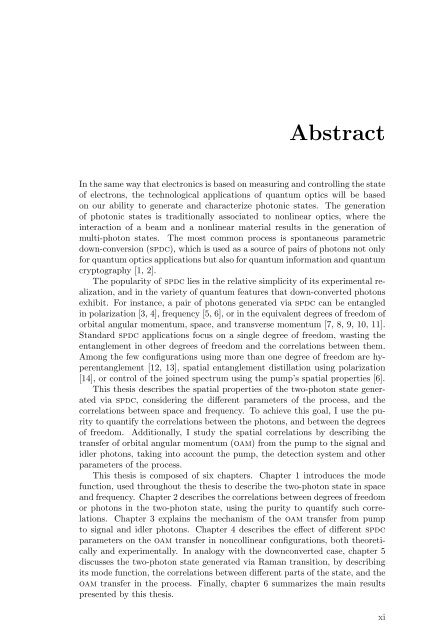Spatial Characterization Of Two-Photon States - GAP-Optique
Spatial Characterization Of Two-Photon States - GAP-Optique
Spatial Characterization Of Two-Photon States - GAP-Optique
You also want an ePaper? Increase the reach of your titles
YUMPU automatically turns print PDFs into web optimized ePapers that Google loves.
Abstract<br />
In the same way that electronics is based on measuring and controlling the state<br />
of electrons, the technological applications of quantum optics will be based<br />
on our ability to generate and characterize photonic states. The generation<br />
of photonic states is traditionally associated to nonlinear optics, where the<br />
interaction of a beam and a nonlinear material results in the generation of<br />
multi-photon states. The most common process is spontaneous parametric<br />
down-conversion (spdc), which is used as a source of pairs of photons not only<br />
for quantum optics applications but also for quantum information and quantum<br />
cryptography [1, 2].<br />
The popularity of spdc lies in the relative simplicity of its experimental realization,<br />
and in the variety of quantum features that down-converted photons<br />
exhibit. For instance, a pair of photons generated via spdc can be entangled<br />
in polarization [3, 4], frequency [5, 6], or in the equivalent degrees of freedom of<br />
orbital angular momentum, space, and transverse momentum [7, 8, 9, 10, 11].<br />
Standard spdc applications focus on a single degree of freedom, wasting the<br />
entanglement in other degrees of freedom and the correlations between them.<br />
Among the few configurations using more than one degree of freedom are hyperentanglement<br />
[12, 13], spatial entanglement distillation using polarization<br />
[14], or control of the joined spectrum using the pump’s spatial properties [6].<br />
This thesis describes the spatial properties of the two-photon state generated<br />
via spdc, considering the different parameters of the process, and the<br />
correlations between space and frequency. To achieve this goal, I use the purity<br />
to quantify the correlations between the photons, and between the degrees<br />
of freedom. Additionally, I study the spatial correlations by describing the<br />
transfer of orbital angular momentum (oam) from the pump to the signal and<br />
idler photons, taking into account the pump, the detection system and other<br />
parameters of the process.<br />
This thesis is composed of six chapters. Chapter 1 introduces the mode<br />
function, used throughout the thesis to describe the two-photon state in space<br />
and frequency. Chapter 2 describes the correlations between degrees of freedom<br />
or photons in the two-photon state, using the purity to quantify such correlations.<br />
Chapter 3 explains the mechanism of the oam transfer from pump<br />
to signal and idler photons. Chapter 4 describes the effect of different spdc<br />
parameters on the oam transfer in noncollinear configurations, both theoretically<br />
and experimentally. In analogy with the downconverted case, chapter 5<br />
discusses the two-photon state generated via Raman transition, by describing<br />
its mode function, the correlations between different parts of the state, and the<br />
oam transfer in the process. Finally, chapter 6 summarizes the main results<br />
presented by this thesis.<br />
xi



